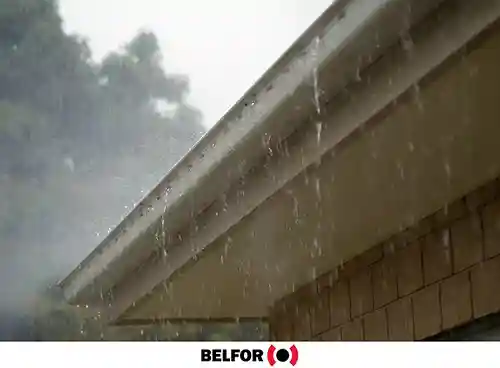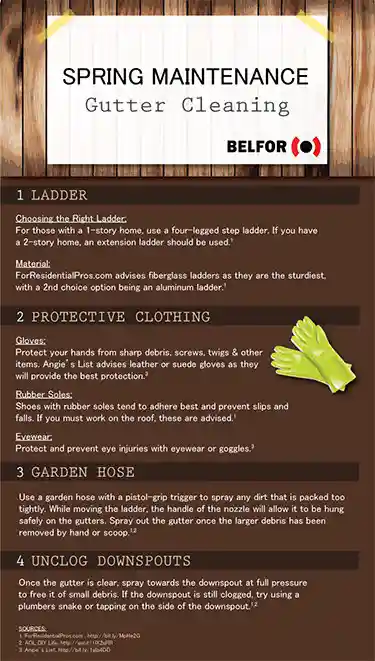Gutter Cleaning
A Guide To Gutter Cleaning
Gutters and downspouts are essential for draining water away from a property. When gutters are clogged, however, the intended drainage path is blocked and water overflows, often going into the property. This can cause a variety of property damage issues, including some as severe as structural failure.
Clogged Gutter Problems
 Without effective and regular cleaning, debris and silt will build up in your guttering and cause blockages in your drainage system. Water then overflows and runs against exterior walls and onto the foundation of your property. Over time, this softens the soil around your house, which can compromise the integrity of your foundation, leading to cracks and eventual structural failure.
Without effective and regular cleaning, debris and silt will build up in your guttering and cause blockages in your drainage system. Water then overflows and runs against exterior walls and onto the foundation of your property. Over time, this softens the soil around your house, which can compromise the integrity of your foundation, leading to cracks and eventual structural failure.
In the shorter term, water seepage from clogged guttering can lead to mold. As water and moisture permeate through your walls, mold spores and bacteria can begin growing on the wet materials. This not only damages your property, but it can also cause health issues for you and your family.
Roof leaks can also result from clogged gutters, especially over winter, when frozen precipitation accumulates on and against the house for long periods of time. If clogged gutters and downspouts prevent melting snow and ice from draining, wall and roof material becomes saturated, causing water to leak into ceilings and interior spaces. Snow and ice melt can also refreeze and form ice dams around the roof and gutters where water would typically drain.
Accumulated debris in your gutters may also attract unwanted wildlife and pests. Wet, organic materials, such as leaves and twigs, serve as a prime source of food and shelter for insects and small rodents. If critters are attracted to the outside of your house, they’re also more likely to try finding a way into your house.
To avoid these unwanted effects, it’s helpful to understand the cleaning and protective measures you can take to properly care for your gutters.
The Cleaning Process
 To protect your property from damage caused by dirty gutters, you should clean your guttering twice a year: once in spring and once in fall.
To protect your property from damage caused by dirty gutters, you should clean your guttering twice a year: once in spring and once in fall.
The number of times you need to clean your gutters each year will vary depending on where you live. For example, if you have a high number of overhanging branches, or are surrounded by pine trees, you might want to consider cleaning your gutters every three months, due to the higher volume of debris falling into your guttering system.
Signs that your gutters need to be cleaned include:
- Pools of water collecting near your house, especially around the foundations
- Dripping gutters in dry weather
- Sagging gutters
Regularly cleaning your gutters will not only protect your house but help your guttering last longer. A well-maintained guttering system can stay intact and in working order for over twenty years.
Prepare: Before you start, get together all the equipment you’ll need, and make sure you are wearing suitable clothing that will protect you from injury. Think about what type of ladder you’ll need and what the risks are, so you can keep yourself safe. In addition to a ladder, other equipment you’ll need includes:
- Thick protective gloves
- A trowel
- A stiff-bristled brush
- A flashlight
Cleaning the downspouts: Clean downspouts first so water can drain freely when you move onto your gutters. Remove twigs, leaves, and other large debris from the base of downspouts. Feed water down them using your hose to try and loosen and remove any clogging. If this does not work, you may need to use a plumber’s snake to shift blockages.
Cleaning the gutters: Start by clearing out all the larger debris that has accumulated in your gutters. Use a powerful garden hose to flush out most of the silt and manually remove what is left, wearing thick gloves.
Protecting Your Gutters
A number of products are available to help you clean out your gutters by keeping leaves and debris out of drainage systems.
Gutter Guards
 Gutter guards are simple screens placed over the top of your guttering, and cost between $7 and $10 per linear foot. The purpose of gutter guards is to stop larger leaves and other debris from entering your guttering. Gutter guards are made of mesh, which is placed over the top of your guttering.
Gutter guards are simple screens placed over the top of your guttering, and cost between $7 and $10 per linear foot. The purpose of gutter guards is to stop larger leaves and other debris from entering your guttering. Gutter guards are made of mesh, which is placed over the top of your guttering.
Water is able to flow freely through the mesh, while leaves, twigs, and stones are held outside it.
Use of gutter guards can prevent blockages and make gutter cleaning less strenuous. When cleaning with gutter guards, brush off debris that has collected on top of the guard, and use a powerful hose to wash out smaller bits of mulch and silt that have made their way through the guard.
Gutter Splash Guards
Acting as upward extensions of your guttering, splash guards stop water from splashing out of gutters and onto your foundation during heavy rainfall. Splash guards are a relatively cheap option for protecting your property and can be bought for around $5 per linear foot. The higher side of the gutter created by the splash guard also helps direct and control water flow, preventing water from building up in unwanted places.
Gutter Aprons
Installed along the edge of your roof at the eaves, a gutter apron hangs into your gutter, allowing water to directly flow from the roof into the guttering. This prevents water from dripping onto your walls and damaging them.
To install a gutter apron, you should be paying around $5 to $7 per linear foot.
By following these gutter cleaning tips and installing some protection to your home you will be able to prevent damage to your property. Water damage can be costly to repair so by taking these steps now you could be saving money in the long run.

